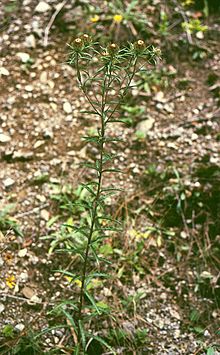Stiff boarwort
| Stiff boarwort | ||||||||||||
|---|---|---|---|---|---|---|---|---|---|---|---|---|

Stiff Eberwurz ( Carlina biebersteinii ) in the subspecies subsp. biebersteinii |
||||||||||||
| Systematics | ||||||||||||
|
||||||||||||
| Scientific name | ||||||||||||
| Carlina Biebersteinii | ||||||||||||
| Bernh. ex Hornem. |
The Stiff Eberwurz ( Carlina biebersteinii ), also called long-leaved Eberwurz or Stiff Golddistel , is a species of the genus Eberwurzen ( Carlina ) from the Asteraceae family.
features
The stiff boarwort is an evergreen , perennial hapaxanthe half- rosette plant and a hemicryptophyte . It reaches heights of growth of 20 to 70, rarely up to 120 centimeters. The stem leaves become shorter from the rosette to the tip of the shoot. The middle stem leaves are usually 6 to 10, rarely up to 15 centimeters long. The stem leaves are either regularly interrupted with fine spines or, rarely, short lobed. They are always flat and only the upper ones are more or less sparse thorn-tipped at their base. The outer husks are comb-shaped fine thorny, coarser thorn corner are more than the share exists.
The flowering period extends from June to September.
ecology
The flowers are pollinated by insects, the seeds are spread by the wind.
Occurrence
The stiff boarwort occurs in Europe and the Middle East. It thrives on silicate grasslands, semi- arid lawns, montane to subalpine meadows and in sparse forests. It occurs in societies of the associations Caricion ferrugineae, Calamagrostion arundinaceae, Mesobromion or Erico-Pinion. She is basenhold , i.e. i.e., it prefers basic soils . In Germany it is scattered in Bavaria in the foothills of the Alps and the Alps and rarely found in Mecklenburg-Western Pomerania on Rügen . The species became extinct in Thuringia and Saxony. In the Allgäu Alps, it rises at the cone heads in Bavaria up to 1900 m above sea level.
Systematics
Three subspecies are distinguished within Central Europe :
- Carlina biebersteinii subsp. biebersteinii is the nominate form , its distribution area corresponds to that of the species. In Germany it occurs scattered in the Bavarian Alpine foothills and the Alps, and rarely in Mecklenburg-Western Pomerania on Rügen. It became extinct in Thuringia. The subspecies grows on montane to subalpine meadows and in sparse forests. It reaches a stature height of 20 to 50, rarely up to 80 centimeters. The stem and the underside of the leaves are initially cobweb-woolly, but with time they become bald. The upper stalk leaves, like the middle ones, are evenly finely toothed, alternating with longer teeth or groups of teeth. They are always flat and rarely lobed short. They narrow evenly from their lower half. The flower heads are usually arranged individually, less often to a few. The variety Carlina biebersteinii subsp. biebersteinii var. fennica Meusel et Kästner, the diameter of the flower heads is 15 to 25 millimeters and these are not dominated by bracts . The flower heads of the variety Carlina biebersteinii subsp. biebersteinii var. biebersteinii reach a larger diameter of 20 to 40 millimeters and are usually dominated by the bracts. The number of chromosomes in the subspecies is 2n = 20.
- The subspecies Carlina biebersteinii subsp. brevibracteata (Andrae) K. Werner rarely occurs in Bavaria near Wolfratshausen and in the Alpine foothills. It grows on silicate grasslands, semi-arid grassland and in sparse forests. The subspecies reaches a stature height of 30 to 70, rarely up to 120 centimeters. The upper stem leaves are different from the middle ones. There are 3 to 5 thorn lobes on each side of the upper stem leaves, which are often a little frizzy. The stem and the underside of the leaves are persistent gray-tomentose to woolly. There are usually several or many flower buttons. These have a diameter of 15 to 25 millimeters and are not dominated by bracts. The number of chromosomes is 2n = 20.
- Carlina biebersteinii subsp. sudetica Kovanda : It only occurs in the Czech Republic.
literature
- Eckehart J. Jäger, Klaus Werner (ed.): Rothmaler excursion flora from Germany. Volume 4: Vascular Plants: Critical Volume . Spektrum Akademischer Verlag, Munich 2005, ISBN 3-8274-1496-2 .
Individual evidence
- ↑ a b c Werner Greuter (2006+): Compositae (pro parte majore). - In: W. Greuter & E. von Raab-Straube (ed.): Compositae. Euro + Med Plantbase - the information resource for Euro-Mediterranean plant diversity. Datasheet Carlina biebersteinii In: Euro + Med Plantbase - the information resource for Euro-Mediterranean plant diversity.
- ^ Erich Oberdorfer : Plant-sociological excursion flora for Germany and neighboring areas . With the collaboration of Angelika Schwabe and Theo Müller. 8th, heavily revised and expanded edition. Eugen Ulmer, Stuttgart (Hohenheim) 2001, ISBN 3-8001-3131-5 , pp. 959 .
- ↑ Erhard Dörr, Wolfgang Lippert : Flora of the Allgäu and its surroundings. Volume 2, IHW, Eching 2004, ISBN 3-930167-61-1 , p. 629.
Web links
- Carlina biebersteinii Bernh. ex Hornem., long-leaved boarwort. In: FloraWeb.de.
- Carlina biebersteinii subsp. brevibracteata (Andrae) Werner, Middle Eberwurz. In: FloraWeb.de.
- Stiff boarwort . In: BiolFlor, the database of biological-ecological characteristics of the flora of Germany.
- Carlina biebersteinii Hornem. s. st. In: Info Flora , the national data and information center for Swiss flora . Retrieved June 9, 2016.
- Carlina biebersteinii subsp. brevibracteata (Andrae) K. Werner In: Info Flora , the national data and information center of the Swiss flora . Retrieved June 9, 2016.
- Thomas Meyer: Gold thistle data sheet with identification key and photos at Flora-de: Flora von Deutschland (old name of the website: Flowers in Swabia )
